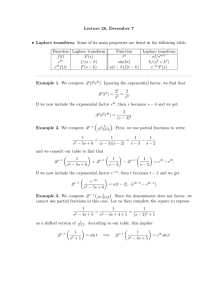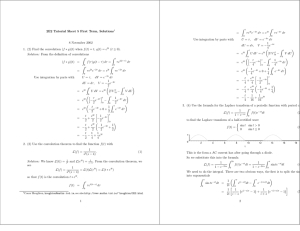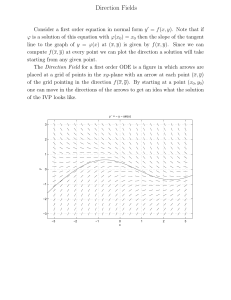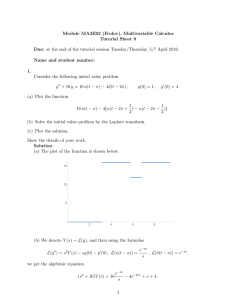2E2 Tutorial Sheet 5 First Term, Solutions 8 November 2002
advertisement
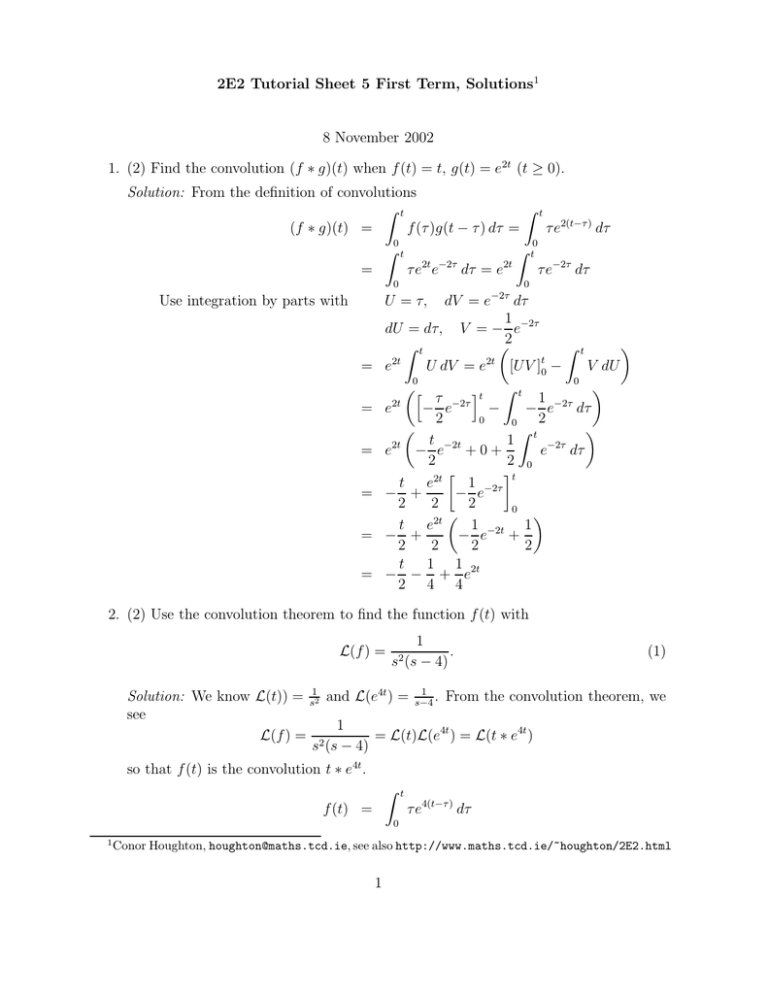
2E2 Tutorial Sheet 5 First Term, Solutions1 8 November 2002 1. (2) Find the convolution (f ∗ g)(t) when f (t) = t, g(t) = e2t (t ≥ 0). Solution: From the definition of convolutions Z t Z t (f ∗ g)(t) = f (τ )g(t − τ ) dτ = τ e2(t−τ ) dτ Z0 t Z t0 τ e2t e−2τ dτ = e2t = τ e−2τ dτ 0 Use integration by parts with 0 U = τ, dV = e−2τ dτ 1 dU = dτ, V = − e−2τ 2 Z t 2t 2t ]t0 Z t [U V − V dU 0 h Z t τ −2τ it 1 −2τ 2t e − − e − e dτ 2 2 0 0 Z 1 t −2τ t −2t 2t e dτ e − e +0+ 2 2 0 t t e2t 1 −2τ − + − e 2 2 2 0 2t 1 −2t 1 t e − e + − + 2 2 2 2 t 1 1 − − + e2t 2 4 4 = e U dV = e 0 = = = = = 2. (2) Use the convolution theorem to find the function f (t) with L(f ) = 1 . − 4) s2 (s (1) 1 Solution: We know L(t)) = s12 and L(e4t ) = s−4 . From the convolution theorem, we see 1 L(f ) = 2 = L(t)L(e4t ) = L(t ∗ e4t ) s (s − 4) so that f (t) is the convolution t ∗ e4t . Z f (t) = 1 t τ e4(t−τ ) dτ 0 Conor Houghton, houghton@maths.tcd.ie, see also http://www.maths.tcd.ie/~houghton/2E2.html 1 Z = Use integration by parts with t 4t −4τ τe e dτ = e 0 4t Z t τ e−4τ dτ 0 U = τ, dV = e−4τ dτ 1 dU = dτ, V = − e−4τ 4 Z t 4t ]t0 4t Z t V dU [U V − 0 h Z t τ −4τ it 1 −4τ 4t e − e dτ − − e 4 4 0 0 Z 1 t −4τ t −4t 4t e dτ e − e +0+ 4 4 0 t t e4t 1 −4τ − + − e 4 4 2 0 4t t e 1 −4t 1 − + − e + 4 4 4 4 1 1 4t t + e − − 4 16 16 = e U dV = e 0 = = = = = 3. (4) Use the formula for the Laplace transform of a periodic function with period c: Z c 1 f (t)e−st dt (2) L(f ) = −cs 1−e 0 to find the Laplace transform of a half-rectified wave sin t sin t > 0 f (t) = 0 sin t ≤ 0 (3) 1 0 2 4 6 8 10 12 14 16 18 t This is the form a AC current has after going through a diode. So we substitute this into the formula Z 2π Z π 1 1 −st L(f ) = f (t)e dt = sin te−st dt 1 − e−2πs 0 1 − e−2πs 0 (4) We need to do the integral. There are two obvious ways, the first is to split the sine into exponentials Z π Z π Z π 1 (i−s)t −(i+s)t −st e dt − e dt sin te dt = 2i 0 0 0 1 1 1 (i−s)π −(i+s)π = e −1 + e −1 (5) 2i i − s i+s 2 Now, we use eiπ = e−iπ = −1 (6) and 1 1 −i − s s+i = =− 2 i−s i − s −i − s s +1 1 1 −i + s s−i = = 2 i+s i + s −i + s s +1 to get Z or L(f ) = π sin te−st dt = 0 1 + e−sπ 1 + s2 (7) (8) 1 1 + e−sπ 1 1 = s2 + 1 1 − e−2sπ s2 + 1 1 − e−sπ (9) where the final equality uses 1 − e−2sπ = 1 − e−sπ 1 + e−sπ The other way to do the integral is to integrate by parts. Briefly, write Z Z π 1 π −st cos te−st dt I= sin te dt = − s 0 0 1 1 −πs 1 +1 + I = − − e s s s and solve for I to get the answer given at (8) above. 3 (10) (11)
